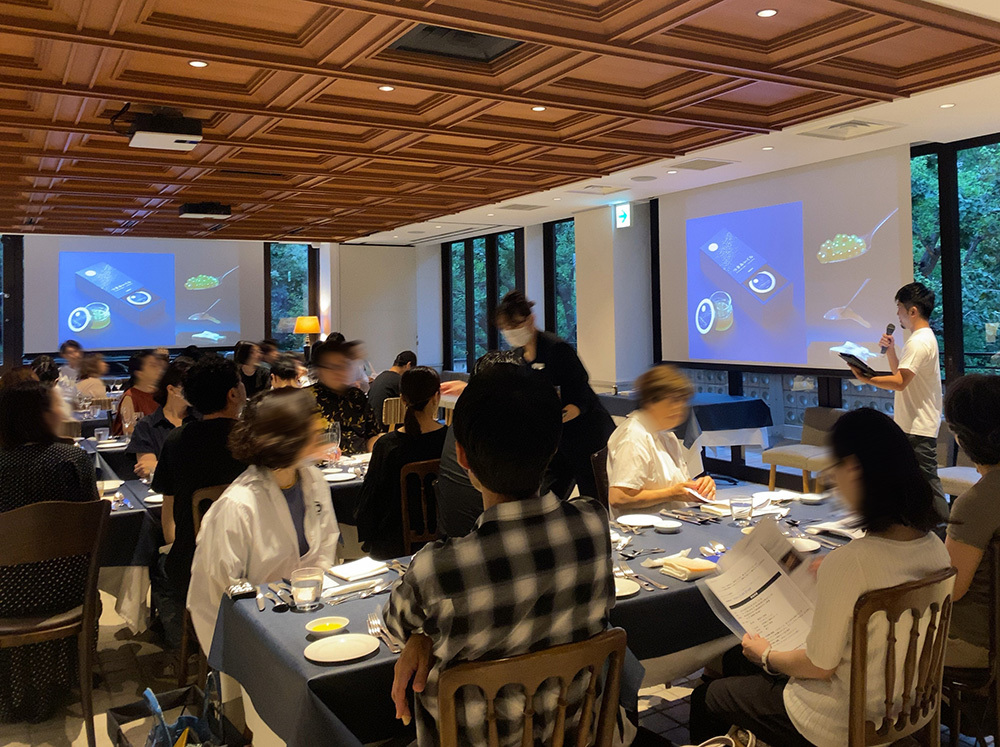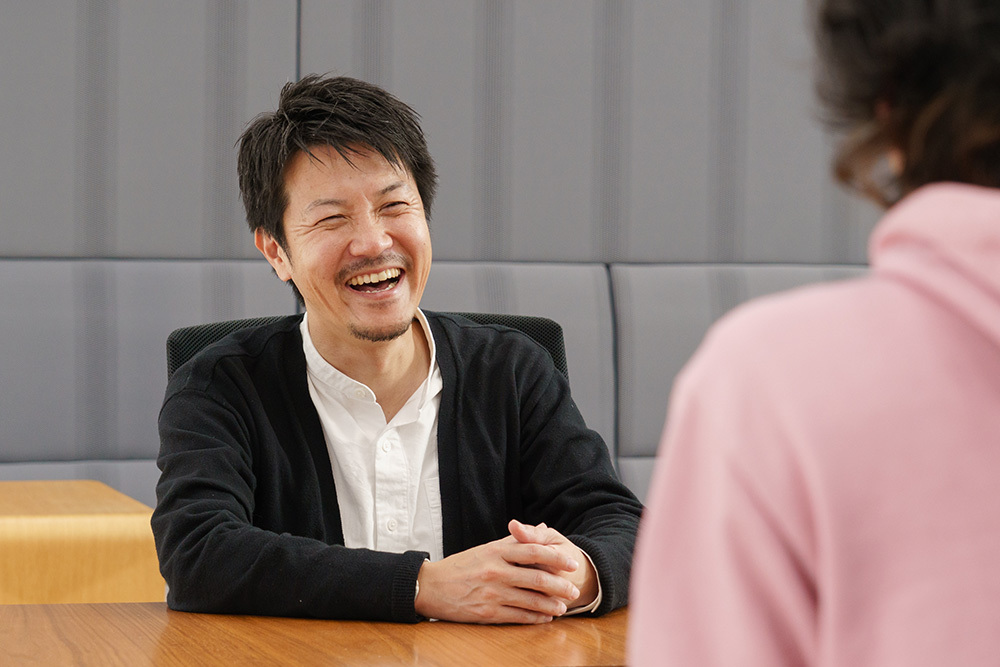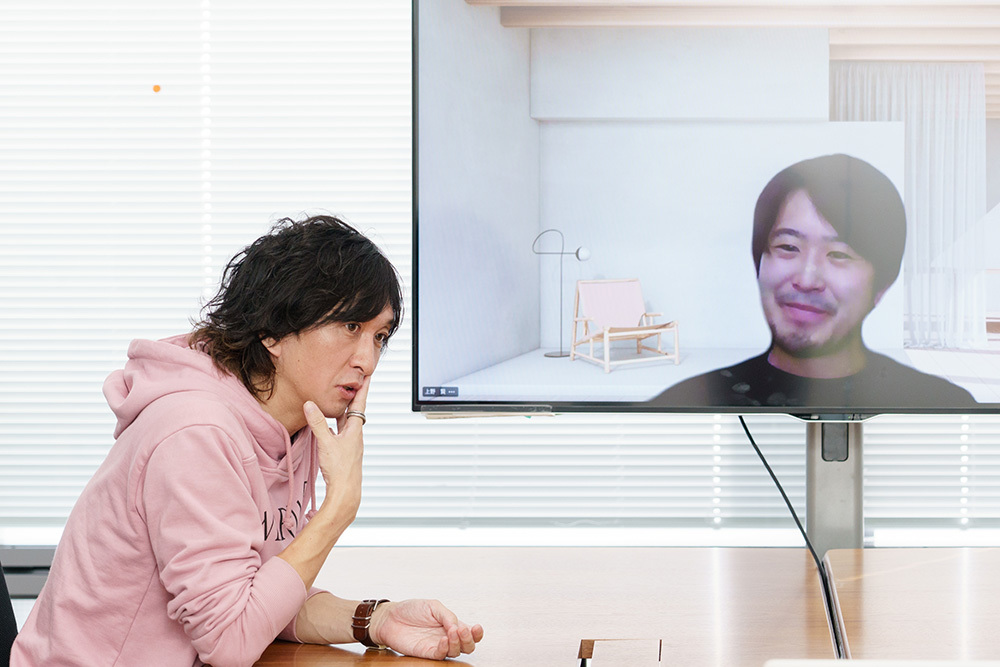Following our previous installment Following our previous discussion, we present case studies illustrating the potential of "Creative Consulting" to boost collaboration between established companies and startups through creative power.
We explore the collaboration between Smolt, a Miyazaki University-spinoff startup engaged in the R&D, production, and sales of Japanese native salmon (Sakura masu) fry; Sazaby League, which aims to create new value through investment and support for Smolt; and Dentsu Consulting Inc., which provided the creative consulting.
In this second part, we hear from Mr. Tsuyoshi Uemura, Head of CVC at Sazaby League's President's Office; Mr. Ken Ueno, CEO of Smolt; and Mr. Masahito Nakagawa, Creative Director at Dentsu Inc. BXCC. They discuss the changes Smolt experienced through the collaboration of these three companies and the value of creativity in brand development through open innovation.

(From right) Mr. Tsuyoshi Uemura, CVC Manager, President's Office, Sazaby League / Mr. Ken Ueno, CEO, Smolt / Mr. Masahito Nakagawa, Creative Director, Dentsu Inc. BXCC
【Smolt Corporation】

Using proprietary technology developed in-house, Smolt focuses on developing superior salmon trout bloodlines. This involves selecting generations of individuals with excellent environmental resilience and other desirable traits, cultivated through the process of experiencing both freshwater and seawater. Drawing parallels to how wild cherry salmon transform into larger, silvery fish with a lustrous, beautiful appearance while adapting to harsh, changing environments, Smolt embodies this challenging way of life and strives to innovate the fisheries industry.
Consistency emerged in messaging, transforming communication with stakeholders
──Last time, you shared how Smolt's statements and brand architecture were rebuilt from a creative perspective. This time, I'd like to hear about the changes these efforts brought to the brand and to you personally, Mr. Ueno.
Ueno: Creating the brand architecture systematically connected ideas that had previously existed as fragmented thoughts in my mind. For example, it allowed me to organize and articulate questions like, "Is this business B2B or B2C?" or "Is it currently B2C, but will it shift to B2B as it grows?" As a result, I can now explain things systematically when speaking with stakeholders like investors.
Additionally, for our product brands, clearly defining the concept differences—such as "truly delicious, premium cherry trout we confidently recommend" versus "delicious but slightly more processed, recommended for those wanting to try cherry trout"—made it easier to communicate with users, suggesting ways to eat it and suitable occasions.
Once you can do this, every creative element—like website design and copy—becomes more refined.

Scene from a tasting event held for stakeholders
Nakagawa: I see. I was truly impressed by the high quality of the finished outputs, like the e-commerce site design and video content.
Uemura: Having a solidly defined statement and brand architecture was crucial—it kept the creative direction consistent.
Nakagawa: I agree. It's crucial to have criteria for judgment, not just for creative work, but for anything: "Does this action align with the statement?" "Is this expression appropriate for the brand?" I believe statements and brand architecture can serve as a compass, pointing us in the right direction.
Ueno: As our creative work has become more refined, we've seen shifts in how people react. One example is FISH FARM SAKURA. When people hear the term "aquaculture," many still conjure negative images—like fish crammed into cramped, poor conditions. But we raise our fish in a clean environment where every detail is meticulously managed. We want to rebrand "aquaculture" by spreading this understanding. That's the vision behind creating the D2C Inc. brand FISH FARM SAKURA.
Ueno: FISH FARM SAKURA leases a facility that once farmed sweetfish. By sharing our vision—"to create a clean environment where fish can thrive freely and eventually become a place accessible to many"—with the local fishing cooperative, they came to understand Smolt's activities more smoothly.
Government officials, too, had previously seen us more as a "university-spinoff venture." But by explaining that we are a brand dedicated to carefully raising fish and living in harmony with nature, we've seen a shift towards supportive actions.
Uemura: Ueno-san was always very skilled at conveying his vision, but even compared to when we first met, his communication has become significantly more effective. At conference pitches, investors are all really hooked and listening intently.
Ueno: I personally feel I've become better at presenting the business in a more compelling way. As we consistently communicated our concept and message, the way we were covered in the media also changed. Before, headlines often framed us as just another student startup. But lately, we're increasingly being featured in contexts like "Transforming Japanese Aquaculture" or "Cultivating and Delivering Delicious Fish."
Uemura: Regarding PR, we received a lot of advice from everyone at Dentsu Inc., starting with Nakagawa-san. What they said made perfect sense immediately, but you can't just be told to come up with those ideas from nothing. Having that objective advice from a communication perspective was truly reassuring.
Wanting to take on challenges with leaders who think from the core
──Sazaby League is a company that places great importance on brands, right? I think nurturing the brands of portfolio companies like Smolt is a key feature of your CVC activities. How do you discover these gems?
Uemura: First, since we're a company connected to consumers, we believe we're a good fit for companies that value the customer perspective. Personally, I prefer leaders who "think from the essence" rather than "think from the system." Like Mr. Ueno, I'm delighted to work with people who engage with the essence of a specific field, deeply understand it, and then act upon that understanding.
Nakagawa: That really captures the essence of Sazaby League's philosophy – engaging with the core.
Uemura: For example, engaging in apparel brand business isn't just about taste—like what's cute or stylish. It also means understanding the essence of apparel, including details like sewing knowledge, techniques, and production systems. Even if you cut corners and create a system that makes money temporarily, it's difficult to build a brand that consumers will love and trust long-term. I believe we've learned this through repeated successes and failures over many years.
Nakagawa: I understand. I feel brands driven by the conviction, "We're doing this because we want to change the world," rather than "We're doing this because it seems profitable," are better able to unleash their creativity.
Uemura: Ueno-san, you're overwhelmingly the latter type, right?
Ueno: That's right. I've even been told by investors, "Ueno-kun, you don't smell like money at all" (laughs). Of course, it's not that I'm not focused on increasing sales, but realizing the world we envision is more important. The people supporting Smolt resonate with my vision and the value our company wants to provide. At least right now, I believe we shouldn't be in a phase focused solely on sales growth. Instead, we should aim to deliver delicious cherry trout to many people and create a world where fishermen take pride in the cherry trout they've raised themselves.
Uemura: Growth is a startup's mission, so I believe appropriate ambition is necessary. But it mustn't become the sole purpose. I want to find companies whose values align with this sense of balance.
We want to accelerate startup growth through the power of creativity
──Finally, please share your enthusiasm and challenges you want to tackle moving forward.
Ueno: Since our founding, we've continuously researched and refined our technology. We've finally reached a point where we can confidently offer products to customers. From here, our focus shifts to refining our D2C Inc. business: how to reach more customers and how to ensure their satisfaction.
To achieve this, we must not only clearly communicate Smolt's worldview and broaden user awareness but also strengthen our connections with producers who share our vision. While expanding our team, we aim to further improve product quality and accelerate business development to deliver delicious cherry trout not only domestically but also internationally.
Uemura: Regarding our collaboration with Smolt, we plan to support their sales channel development both domestically and internationally by leveraging our assets. While it may not yet be at the stage of open innovation, we also intend to explore synergies with our existing businesses and the potential for new business development.
Furthermore, as a CVC, we plan to expand our investment activities. When collaborating with startups in the future, we expect to encounter similar challenges. We want to leverage our capabilities, supported by Dentsu Inc. where our own are insufficient, to drive activities that accelerate growth and scale startups through creative power.
Nakagawa: Creating Smolt's core engine—its statements and brand architecture—together was an incredibly valuable experience for us as well. As the brand grows and moves through different stages, the nature of the challenges will change, so we believe there will be many ways we can assist. And we'd be delighted if we could share the same vision for the future that Sazaby League and Smolt have. We look forward to continuing our collaboration.
For inquiries, please contact:
Dentsu Inc. BX Creative Center: contact@dentsu-bxcr.com
BX Creative Center Website: https://dentsu-bxcr.com/













